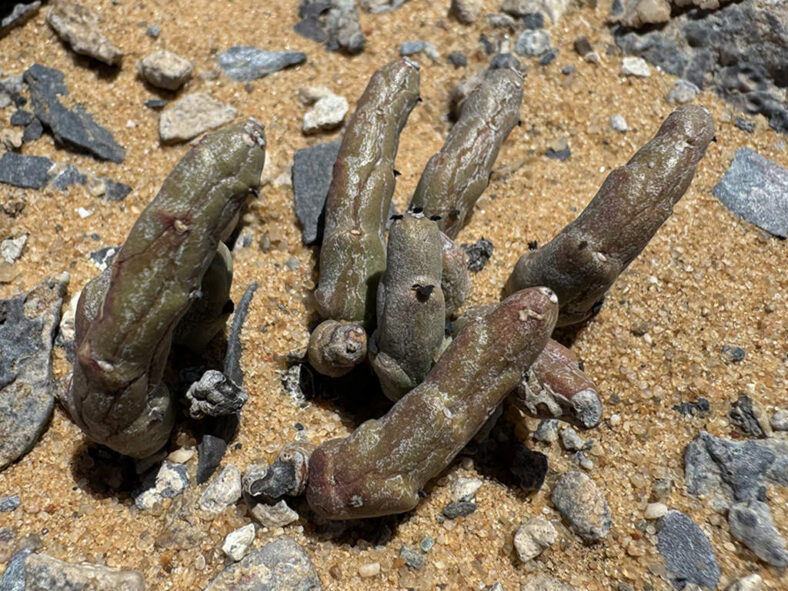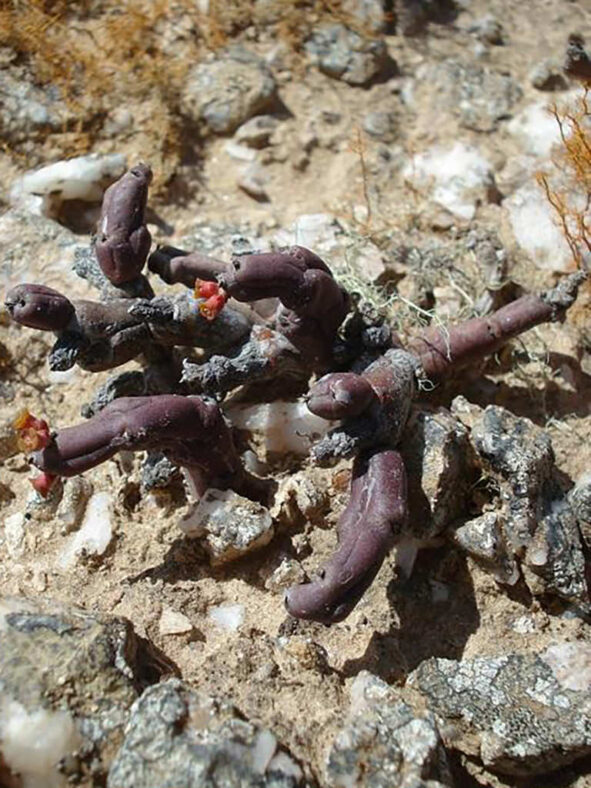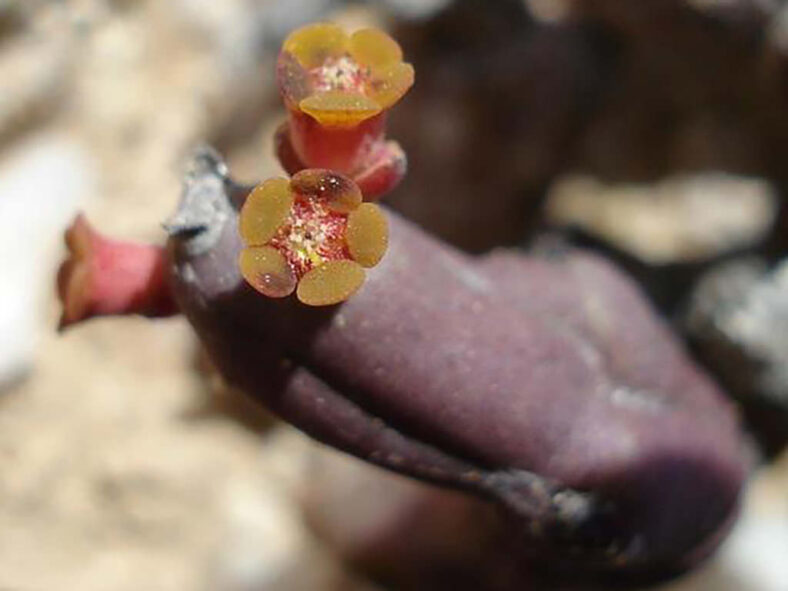There is some confusion between Euphorbia stapelioides and Euphorbia succulenta. Here is a brief history of this confusion:
In 1909, Ferdinand Albin Pax describes Monadenium stapelioides. Later, in 1935, Herold G. W. J. Schweickerdt described Monadenium succulentum, believing it to be a different species. Over time, these two names were treated as synonyms, with Monadenium stapelioides being the older name and Monadenium succulentum becoming forgotten.
In 2006, Peter Vincent Bruyns wanted to move Monadenium stapelioides into the genus Euphorbia but could not use the name Euphorbia stapelioides due to an existing species with that name. As a result, he coined the new name Euphorbia neostapelioides. In 2007, after realizing there was an older, forgotten synonym that should have been used, he formally established the name Euphorbia succulenta.
This species is rare in cultivation, and the plants sold as Euphorbia stapelioides are actually Euphorbia succulenta, formerly known as Monadenium stapelioides.
Scientific Name
Euphorbia stapelioides Boiss.
Synonym(s)
Euphorbia lumbricalis, Tirucalia stapelioides
Scientific Classification
Family: Euphorbiaceae
Subfamily: Euphorbioideae
Tribe: Euphorbieae
Subtribe: Euphorbiinae
Genus: Euphorbia
Etymology
The specific epithet "stapelioides" (pronounced "sta-pel-ee-OY-deez") means "resembling Stapelia" and refers to the likeness of this species to the members of the genus Stapelia.
Origin
The native range of Euphorbia stapelioides extends from Oranjemund in southwestern Namibia to Koekenaap in the Western Cape province of South Africa. It grows in red loam and gravelly slopes, sometimes with windblown sand.
Description
Euphorbia stapelioides is a dwarf succulent with an underground tuber and several fleshy, spineless branches that may be cylindrical or slightly tapering. The branches can grow up to 4 inches (10 cm) long and 1 inch (2.5 cm) in diameter. They are gray-green with a tinge of purple, becoming almost entirely purple in intense sunlight. The tiny leaves are soon deciduous, varying in shape from narrowly triangular to deltoid.
Typically, in the fall, Euphorbia stapelioides produces a few cyathia at the tip of the stems. Each cyathium has five yellow-green glands and can reach a diameter of 0.12 inches (0.3 cm). The fruits are exserted capsules, often covered with short, soft hair, and can measure up to 0.16 inches (0.4 cm) in diameter. This species is dioecious, meaning it has separate male and female flowers on different plants.

How to Grow and Care for Euphorbia stapelioides
Light: For optimal growth, your Euphorbia stapelioides needs plenty of sunlight. During the warmer months, place it near a sunny window or move it to your balcony or garden, gradually increasing sun exposure to avoid sunburn.
Soil: Use a well-draining soil, either a commercial potting mix formulated for succulents or create your own well-draining soil.
Temperature: While high summer temperatures are not a problem, low winter temperatures can damage or kill your plant. Euphorbia stapelioides grows best in USDA Plant Hardiness Zones 10a to 11b, with average minimum winter temperatures ranging from 30 to 50 °F (-1.1 to 10 °C).
Watering: From spring to fall, water the plant when the soil's top inch (2.5 cm) feels dry. Reduce watering in winter and give it just enough water to prevent wilting. In the warm season, evening is the best time of the day for watering.
Fertilizing: To ensure the potted plant receives sufficient nutrients, apply a balanced fertilizer in a 10-10-10 NPK formulation, diluted to 1/4 strength weekly during the growing season.
Repotting: Although your Euphorbia stapelioides does not need to be repotted often, it will benefit from repotting when it outgrows its pot. Repotting is best done in early spring, at the beginning of the growing season. When handling this plant, wear gloves, protective clothing, and appropriate eye protection.
Propagation: The easiest and fastest method to propagate this plant is by stem cuttings. While starting Euphorbia stapelioides from seeds is possible, germination can be challenging. Take cuttings only during the growing season. Spring is the ideal time to sow the seeds.
Learn more at How to Grow and Care for Euphorbia.
Toxicity of Euphorbia stapelioides
Euphorbia stapelioides produces a poisonous white milky sap that may cause burns or irritation if it comes into contact with the skin or eyes. Therefore, it is best to keep this plant away from children and pets.
Links
- Back to genus Euphorbia
- Succupedia: Browse succulents by Scientific Name, Common Name, Genus, Family, USDA Hardiness Zone, Origin, or cacti by Genus
Photo Gallery
Click on a photo to see a larger version.


